Nuclear factor of activated T cells c is a target of p38 mitogen-activated protein kinase in T cells
- PMID: 12944472
- PMCID: PMC193716
- DOI: 10.1128/MCB.23.18.6442-6454.2003
Nuclear factor of activated T cells c is a target of p38 mitogen-activated protein kinase in T cells
Abstract
p38 mitogen activated protein kinase (MAPK) is essential for T-cell activation. Here we demonstrated that nuclear factor of activated T cells (NFAT) is a direct target of p38 MAPK. Inhibition of p38 MAPK led to selective inactivation of NFAT in T cells. We further linked a strict requirement of p38 MAPK to activation of NFATc. A stimulatory effect of p38 MAPK on at least four other stages of NFATc activation was found. First, the p38 MAPK cascade activated the NFATc promoter and induced the transcription of NFATc mRNA. Second, p38 MAPK mildly increased the mRNA stability of NFATc. Third, p38 MAPK enhanced the translation of NFATc mRNA. Fourth, p38 MAPK promoted the interaction of NFATc with the coactivator CREB-binding protein. In contrast, p38 MAPK moderately enhanced the expulsion of NFATc from the nucleus in T cells. Therefore, p38 MAPK has opposite effects on different stages of NFATc activation. All together, the overall effect of p38 MAPK on NFATc in T cells is clear activation.
Figures
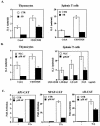

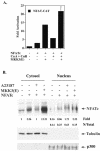
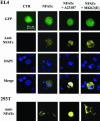
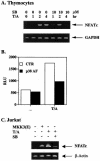
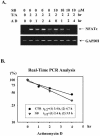
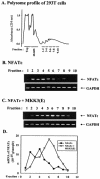

Similar articles
-
Role of bioavailable iron in coal dust-induced activation of activator protein-1 and nuclear factor of activated T cells: difference between Pennsylvania and Utah coal dusts.Am J Respir Cell Mol Biol. 2002 Nov;27(5):568-74. doi: 10.1165/rcmb.4821. Am J Respir Cell Mol Biol. 2002. PMID: 12397016 Free PMC article.
-
Tpl-2 induces IL-2 expression in T-cell lines by triggering multiple signaling pathways that activate NFAT and NF-kappaB.Oncogene. 1998 Nov 19;17(20):2609-18. doi: 10.1038/sj.onc.1202460. Oncogene. 1998. PMID: 9840924
-
A role for the extracellular signal-regulated kinase and p38 mitogen-activated protein kinases in interleukin-1 beta-stimulated delayed signal tranducer and activator of transcription 3 activation, atrial natriuretic factor expression, and cardiac myocyte morphology.J Biol Chem. 2001 Aug 3;276(31):29490-8. doi: 10.1074/jbc.M100699200. Epub 2001 May 29. J Biol Chem. 2001. PMID: 11382751
-
Requirement of the p38 mitogen-activated protein kinase signalling pathway for the induction of the 78 kDa glucose-regulated protein/immunoglobulin heavy-chain binding protein by azetidine stress: activating transcription factor 6 as a target for stress-induced phosphorylation.Biochem J. 2002 Sep 15;366(Pt 3):787-95. doi: 10.1042/BJ20011802. Biochem J. 2002. PMID: 12076252 Free PMC article.
-
Calcineurin-NFAT signaling regulates the cardiac hypertrophic response in coordination with the MAPKs.Cardiovasc Res. 2004 Aug 15;63(3):467-75. doi: 10.1016/j.cardiores.2004.01.021. Cardiovasc Res. 2004. PMID: 15276472 Review.
Cited by
-
Regulation of Cyclooxygenase-2 Expression in Human T Cells by Glucocorticoid Receptor-Mediated Transrepression of Nuclear Factor of Activated T Cells.Int J Mol Sci. 2022 Oct 31;23(21):13275. doi: 10.3390/ijms232113275. Int J Mol Sci. 2022. PMID: 36362060 Free PMC article.
-
p38 MAPK signaling mediates retinoic acid-induced CD103 expression in human dendritic cells.Immunology. 2020 Nov;161(3):230-244. doi: 10.1111/imm.13246. Epub 2020 Sep 14. Immunology. 2020. PMID: 32737889 Free PMC article.
-
PCSK9 in T-cell function and the immune response.Biomark Res. 2024 Dec 31;12(1):163. doi: 10.1186/s40364-024-00712-8. Biomark Res. 2024. PMID: 39736777 Free PMC article. Review.
-
Retinoic Acid Modulates Hyperactive T Cell Responses and Protects Vitamin A-Deficient Mice against Persistent Lymphocytic Choriomeningitis Virus Infection.J Immunol. 2020 Jun 1;204(11):2984-2994. doi: 10.4049/jimmunol.1901091. Epub 2020 Apr 13. J Immunol. 2020. PMID: 32284332 Free PMC article.
-
ATP/IL-33-triggered hyperactivation of mast cells results in an amplified production of pro-inflammatory cytokines and eicosanoids.Immunology. 2021 Nov;164(3):541-554. doi: 10.1111/imm.13386. Epub 2021 Jun 30. Immunology. 2021. PMID: 34142370 Free PMC article.
References
-
- Avots, A., M. Buttmann, S. Chuvpilo, C. Escher, U. Smola, A. J. Bannister, U. R. Rapp, T. Kouzarides, and E. Serfling. 1999. CBP/p300 integrates Raf/Rac-signaling pathways in the transcriptional induction of NF-ATc during T cell activation. Immunity 10:515-524. - PubMed
-
- Ballinger, D. G., and M. L. Pardue. 1983. The control of protein synthesis during heat shock in Drosophila cells involved altered polypeptide elongation rate. Cell 33:103-144. - PubMed
-
- Beals, C. R., C. M. Sheridan, C. W. Turck, P. Gardner, and G. R. Crabtree. 1997. Nuclear export of NF-ATc enhanced by glycogen synthase kinase-3. Science 275:1930-1934. - PubMed
-
- Chen, C. Y., and A. B. Shyu. 1995. AU-rich elements: characterization and importance in mRNA degradation. Trends Biochem. Sci. 20:465-470. - PubMed
Publication types
MeSH terms
Substances
LinkOut - more resources
Full Text Sources
Miscellaneous
